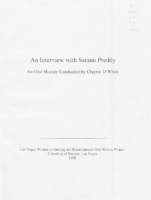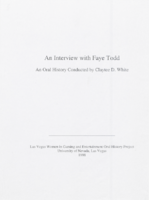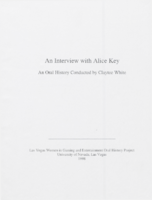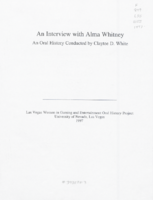Search the Special Collections and Archives Portal
Search Results

Transcript of interview with Katherine McKee by Claytee D. White, September 3, 2016.
Date
Archival Collection
Description
Interviewed by Claytee White. History of passing in Las Vegas after integration is mandated. McKee danced at the Mint, The Silver Slipper's Minsky's Burlesque and the Dune's Viva Les Girls. Performed in Les Girls Montreal road show as well. Hosted the Los Angeles Morning Show, actress in many shows and movies, and was Sammy Davis' "road wife."
Text

Transcript of interview with LaVerne Ligon, BJ Thomas, and Leonard Polk conducted by Claytee D. White, July 9, and July 18, 2012
Date
Archival Collection
Description
LaVerne Ligon was born in 1942 in Washington D.C. Around the age of nine, she started dancing at the Jones-Haywood School of Ballet, which started her career in dance. She took her first job as a professional dancer when she was eighteen with the Capitol Ballet Company. She moved to Las Vegas, Nevada in 1973. In 1974, she successfully auditioned for a touring cast of Hello, Dolly! After completing that show, Ligon performed in a number of productions in Las Vegas, including Hallelujah Hollywood and Jubilee. She retired from dancing in the early 1980s after sustaining an injury and she opened the Simba Talent Agency, a dance school for at-risk youth. She also worked for Family Services, but is now retired. She continues to work on projects with the Simba Talent Agency. BJ Thomas was born in 1935 in Plain Dealing, Louisiana. He moved to Las Vegas in 1968 after working for the Post Office in San Francisco. He worked a number of jobs for two years before beginning to pursue work as a stage hand. Thomas worked for shows at the Tropicana and Caesars Palace. He is currently retired. Leonard Polk Jr. was born in 1948 in Monroe, Louisiana. He and his mother moved to Las Vegas in 1949 when he was just two months old. His father worked on the Hoover Dam. Polk grew up in West Las Vegas and remembers the movement to integrate the schools in the city. As a young adult, he joined the Marines and served a tour of duty in Vietnam. Polk began to work for shows in Las Vegas after he finished his military career. He worked for the Aladdin Baghdad Theater and for the MGM Grand Hotel. He is currently retired, but remains active with the First African Methodist Episcopal Church.
Text

Transcript of interview with Sarann Knight Preddy by Claytee D. White, June 5, 1997
Date
Archival Collection
Description
Interview with Sarann Knight Preddy conducted by Claytee D. White on June 5, 1997. Preddy moved to Hawthorne, Nevada, in the 1940s, becoming a business owner and president of the NAACP. Later she moved to Las Vegas, where she served as a community activist and worked as one of the first black 21-dealers.
Text

Transcript of interview with Faye Todd by Claytee D. White, October 15, 1996
Date
Archival Collection
Description
Interview with Faye Todd conducted by Claytee D. White on October 15, 1996. Featured in Ebony Magazine in 1979, Todd achieved executive status in the Las Vegas gaming industry, serving as Special Events Coordinator for Desert Inn Hotel and Casino and Entertainment Director/Corporate Executive Assistant for Landmark Hotel and Casino.
Text

Transcript of interview with Sarann Knight by Yvonne Hunter, July 16, 1975
Date
Archival Collection
Description
Interview with Sarann Knight [Preddy] conducted by Yvonne Hunter on July 16, 1975. Preddy moved to Hawthorne, Nevada, in the 1940s, becoming a business owner and president of the NAACP. Later she moved to Las Vegas, where she served as a community activist and worked as one of the first black 21-dealers.
Text

Transcript of interview with D. D. Cotton by Claytee D. White, February 14, 1997
Date
Archival Collection
Description
Interview with D. D. Cotton conducted by Claytee D. White on February 14, 1997. Raised in New York City, Cotton arrived in Las Vegas as a dancer in Cab Calloway's traveling production "The Cotton Club." During a period of strained race relations, she stood for equal rights as the first black cocktail waitress on the Strip and one of the first black dealers.
Text

Transcript of interview with Alice Key by Claytee D. White, February 17, 1997
Date
Archival Collection
Description
Interview with Alice Key conducted by Claytee D. White on February 17, 1997. Dancer, writer, and community activist, Key served as Deputy Labor Commissioner for the State of Nevada and leader of the NAACP in Las Vegas. As a newspaper reporter, she exposed the separation of blood plasma according to race in World War II. With Bob Bailey, Key created the first all-black television show in the nation and a radio program, interviewing black entertainers in a talk-show format.
Text

Transcript of interview with Vicki Richardson by Claytee D. White, August 19, 2003
Date
Archival Collection
Description
Interview with Vicki Richardson conducted by Claytee D. White on August 19, 2003. As a high school junior in Wilmington, Delaware, Richardson was one of twelve African American students chosen to integrate the school system. A civil rights activist in high school and college, Richardson wrote letters to local newspapers and engaged in protests to desegregate public spaces. Inspired by Harlem Renaissance painters, Richardson paid her way through college by teaching art at a recreation center. She went on to Vanderbilt University and later the University of Chicago where she had a Ford Foundation Fellowship to study inner-city education. She taught at Forestville High School in Chicago where she was Chairwoman of the Art Department and later at Rancho High School in Las Vegas. Richardson owns Left of Center Art Gallery in North Las Vegas and several other local businesses.
Text

Transcript of interview with Anna Bailey by Claytee D. White, March 3, 1997
Date
Archival Collection
Description
Interview with Anna Bailey conducted by Claytee D. White on March 3, 1997. Arriving in Las Vegas in 1955 to perform as a dancer for the opening of the Moulin Rouge, Bailey also starred in traveling shows nationally and in Europe. Returning to Las Vegas, she became the first African American to dance in a house chorus line on the Strip. Later she became one of the first black women in Nevada to hold a gaming license, owning and operating several small nightclubs.
Text

Transcript of interview with Alma Whitney by Claytee D. White, March 3, 1996
Date
Archival Collection
Description
Interview with Alma Whitney conducted by Claytee D. White on March 3, 1996. Seeking better employment opportunities, Whitney moved to Las Vegas from Tallulah, Louisiana, at the age of sixteen. Whitney supported Westside churches and schools and was respected as supervisor in housekeeping at Desert Inn. Whitney provides information on the African American migration to Las Vegas during the 1940s, post-war race relations in Las Vegas, the daily work of hotel maids, and the Culinary Union.
Text
